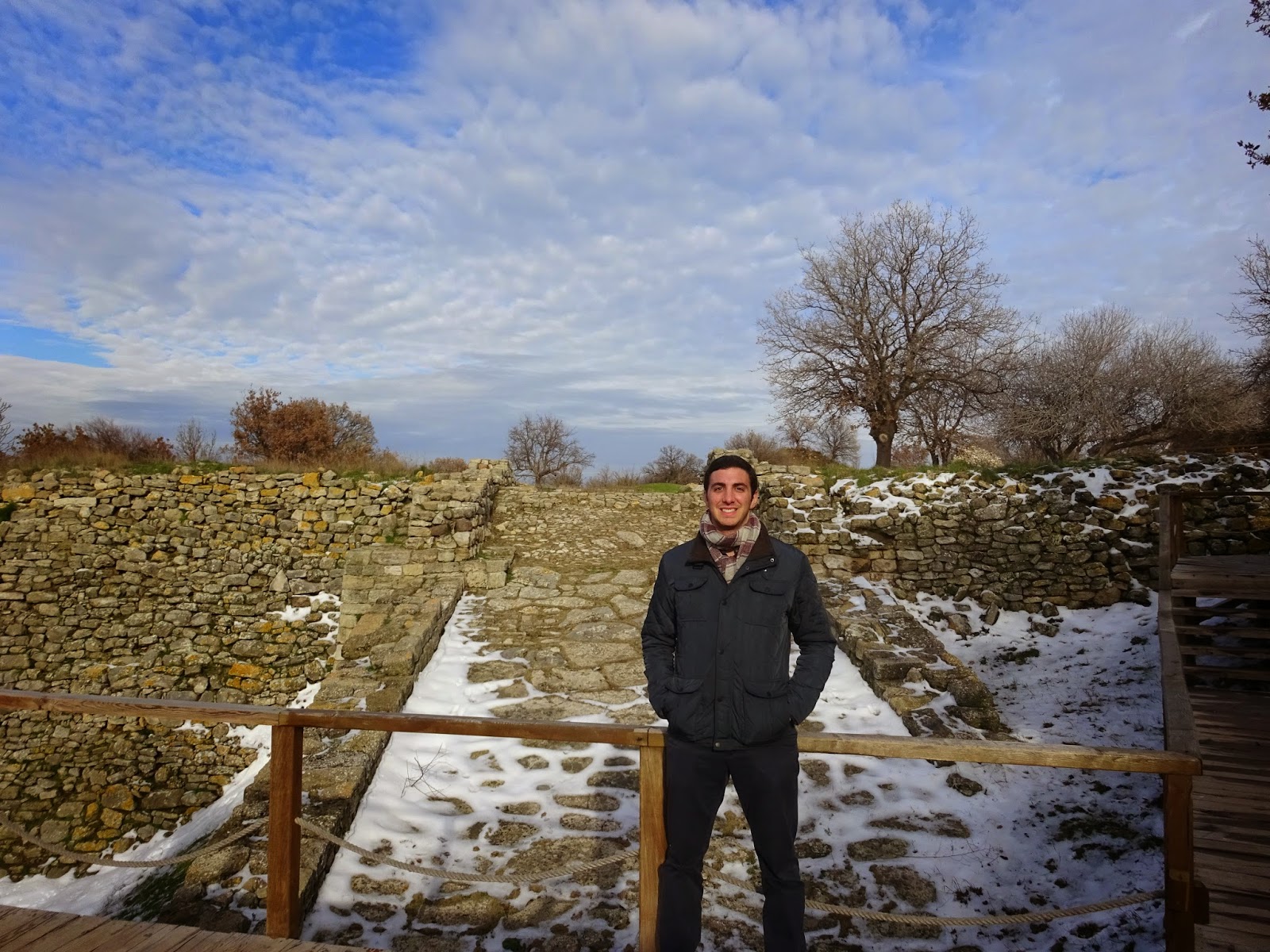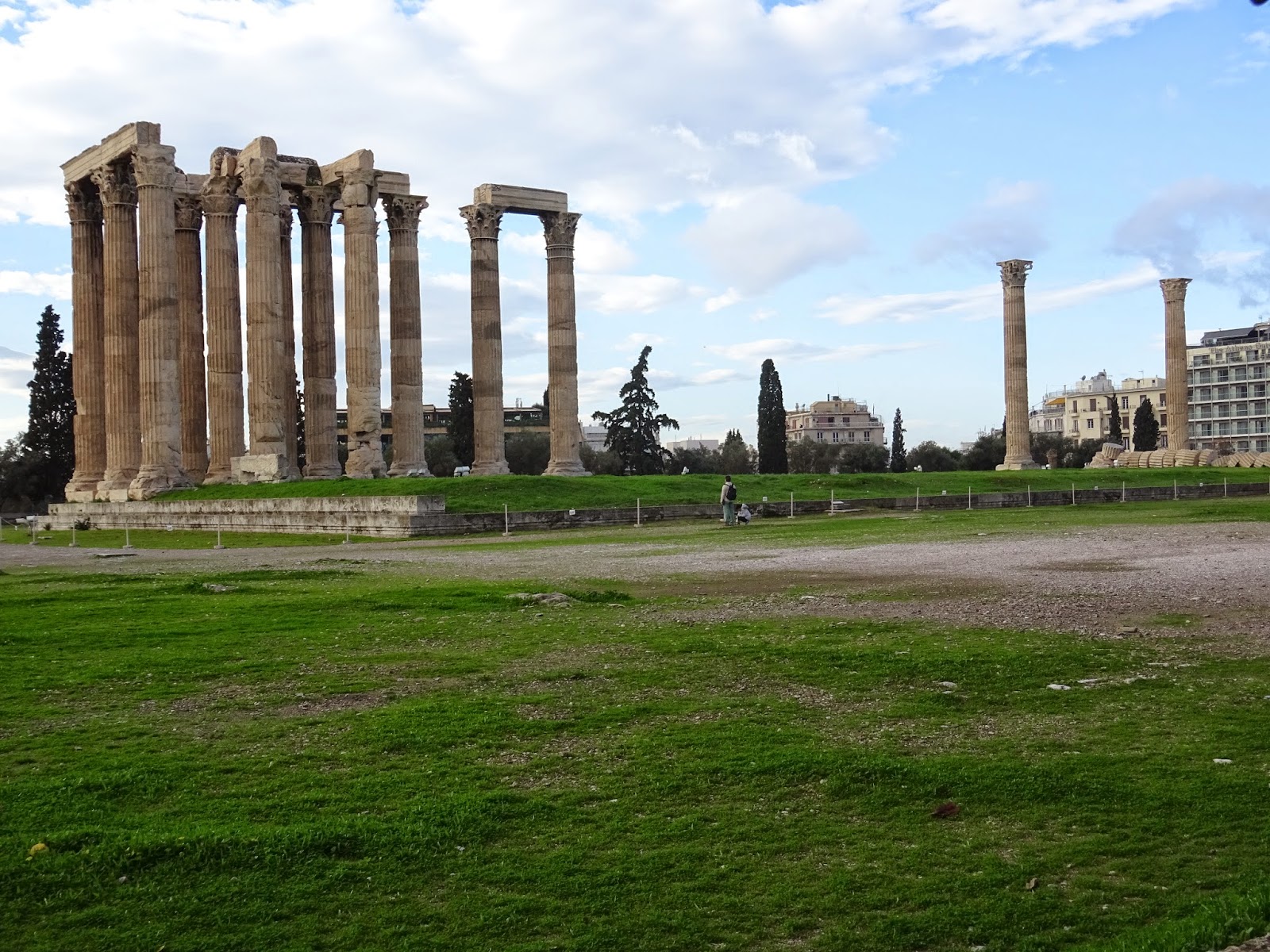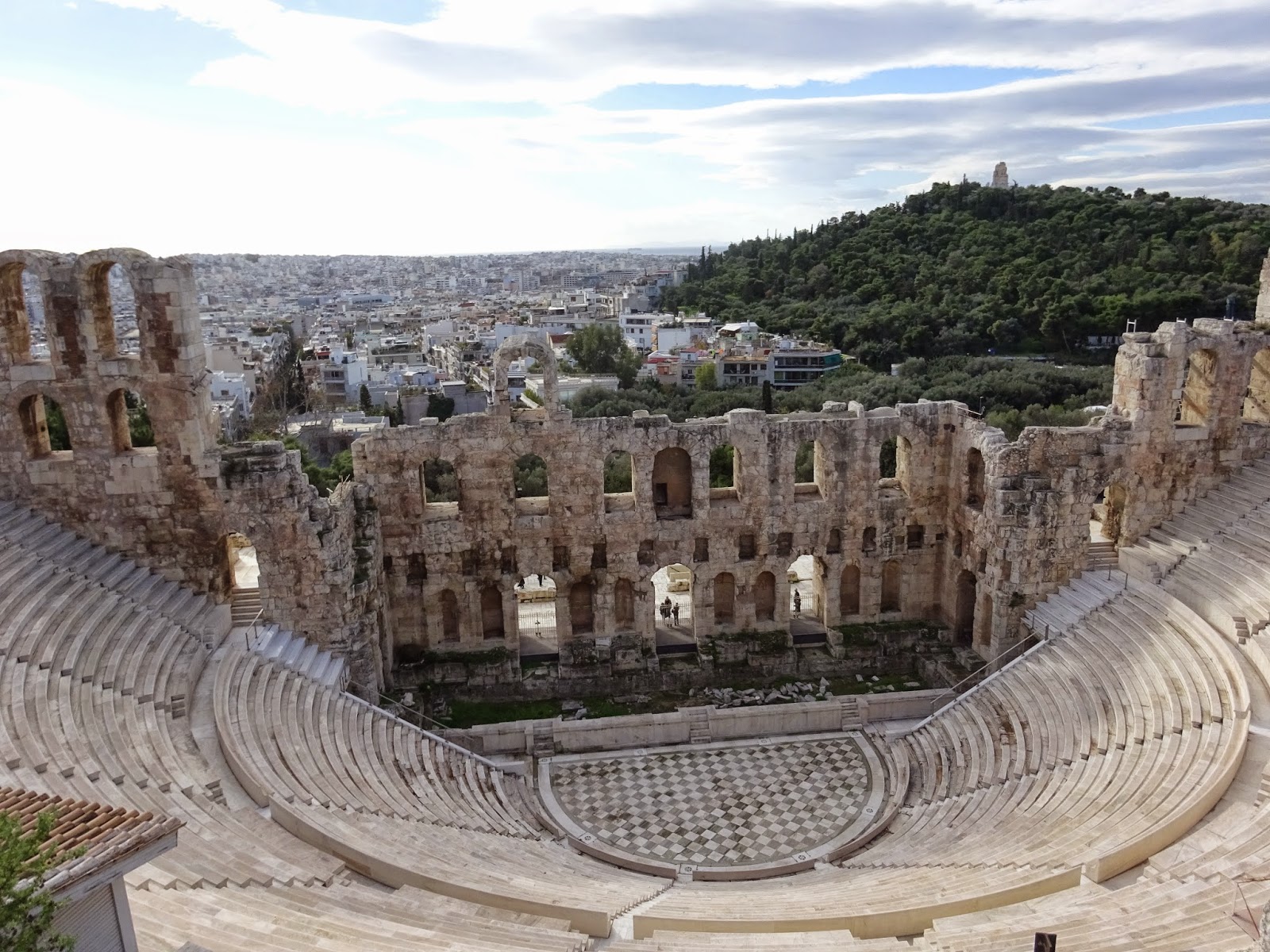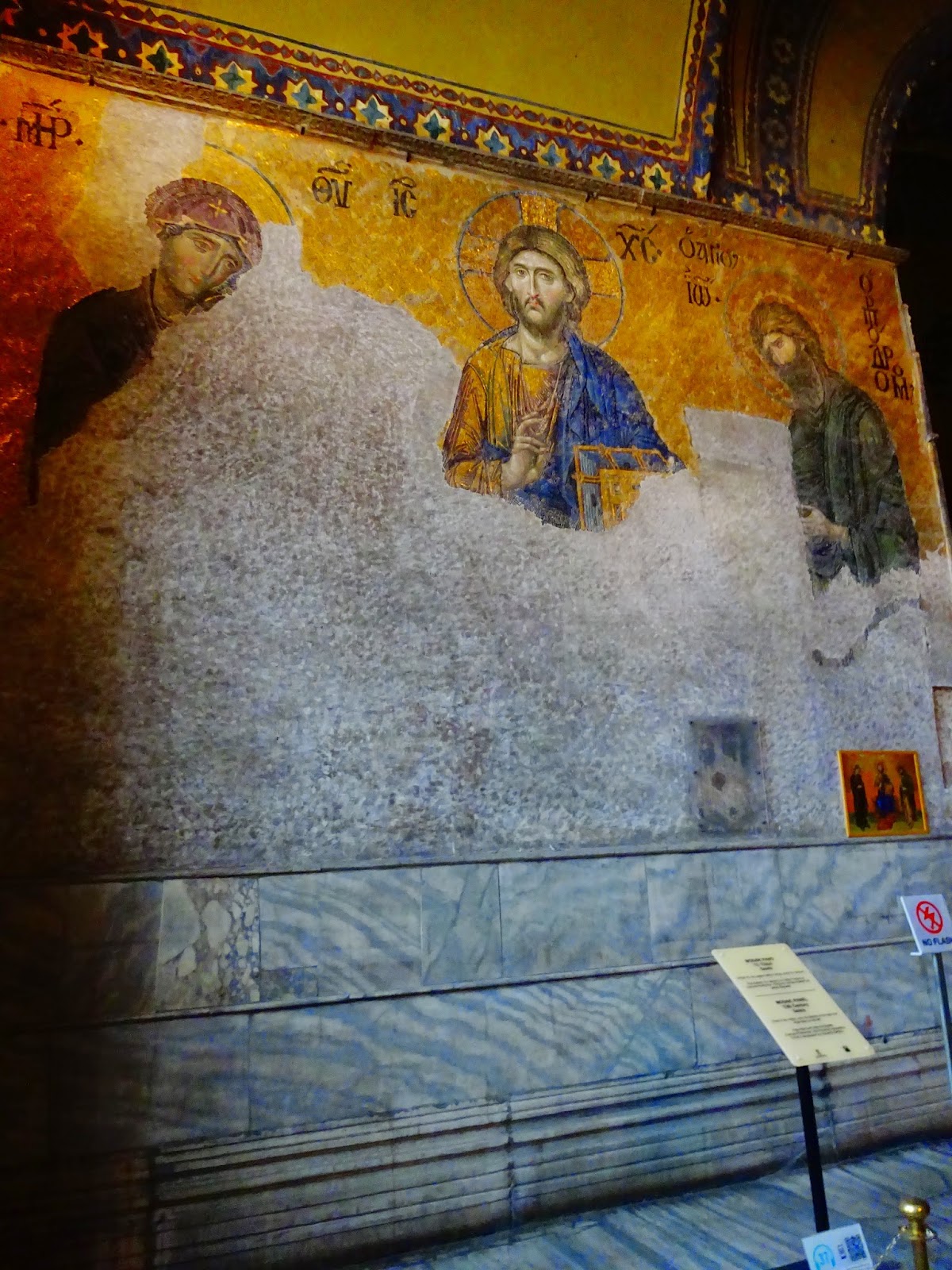Hey everyone! Didi bodishi (= sorry) for leaving you in the dark for almost three months. There have been lots of happenings, most notably winter break!
At the end of my last post I mentioned my plans to meet up with my mom and brother in Greece and Turkey. In an instance of the worst timing ever, my mom got a bad case of the flu right before they were supposed to leave and they ended up having to cancel. Luckily I was able to meet up with some friends in both Greece and Turkey, so I wasn’t completely alone the whole time. It was an amazing trip regardless.
My first day in Athens I spent a while at the Acropolis Museum, which contains myriad excavated sculptures, friezes, reliefs, pottery pieces, etc. from… you guessed it, the Acropolis! For those of you less classically inclined, the Acropolis was the major citadel in Athens where the Parthenon and a few other important temples stood.
After the museum I wandered around the city for the rest of the day, mostly in the Psyrri district, which is known for its abundance of restaurants and bars. Close by was Monastiraki Square, the location of the Church of the Pantanassa and the Tzistarakis Mosque. The church is what remains of a 10th century monastery, and the mosque is an 18th century Ottoman mosque that now houses pieces from the Museum of Greek Folk Art. A little past the square is Ermou Street, a walking street that is one of the busiest streets in Athens. There's a little square on the street with an 11th century Byzantine church, Kapnikarea Church.
 |
| Church of the Pantanassa and the Tzistarakis Mosque in the background |
 |
| Kapnikarea Church |
The following day I did a guided tour of Athens. Our first stop was the Panathenaic Stadium, which hosted the first modern Olympics in 1896. It also happens to be the only 100% marble stadium in the world.
Our next stop was the 5th century BC Temple of Zeus.
As we made our way up to the Acropolis we stopped at the Areopagus, or Ares/Mars Hill. This was the site of the Council of the Areopagus, the ruling aristocratic body of ancient Athens, as well as the site of the high court of Athens. The Areopagus is also where Apostle Paul delivered a famous sermon to the Athenian people, and there is a plaque in which Paul’s speech is inscribed.
 |
| The Areopagus hill and plaque of Paul's speech |
 |
| View of Athens from the Areopagus |
 |
| The view in another direction |
 |
| The Areopagus as seen from the Acropolis |
Before entering the Acropolis, we passed by the Odeon of Herodes Atticus. Mr. Atticus was a wealthy Athenian aristocrat and Roman consul who paid for the theater’s construction in 161.
The Propylaea, or the monumental gateway to the Acropolis, is the model for such structures as Berlin’s Brandenburg Gate.
 |
| Entrance to the Acropolis and Propylaea |
 |
| Back of the Propylaea |
Inside the Acropolis is the Parthenon, the most important building left standing from Greece’s Classical period, which is typically categorized as the 5th and 4th centuries BC. The Parthenon, along with the Propylaea and the Temple of Athena, were built during Pericles' rule in the mid-5th century BC.
 |
| The Parthenon |
 |
 |
| Temple of Athena |
 |
| View of Athens |
 |
| Temple of Zeus as seen from the Acropolis |
Our tour guide throughout the day was really knowledgeable, and he was even a big fan of Peace Corps! He used to live in Albania and knew some Peace Corps Albania volunteers from his time there. I also found out that the Georgian word for “Friday” is exactly the same as in Greek, and the Georgian system of naming days by their distance after Saturday comes from Greek as well (i.e. in Georgian and Greek, Monday = “second Saturday”).
The next day I took a tour out to Delphi, which is about 3 hours outside of Athens on the slopes of Mount Parnassus. In ancient Greece, Delphi was home to the Pythia, also known as the Oracle of Delphi, who was the priestess of the Temple of Apollo at any given time and the most renowned oracle in Greece. The Oracle is referenced countless times in ancient works - readers of Oedipus might remember that Oedipus travels to the Delphic Oracle to ask who his biological parents are, and Plato’s Apology tells us that the Oracle was responsible for setting Socrates on his philosophical quest of inquiry.
We started off with a tour of the Delphi museum, which contained many artifacts from the Temple of Apollo and surrounding area.
After the museum we started our climb up the mountainside to the remains of the Temple of Apollo, and then higher up past the temple towards the theater. It was lightly snowing and our tour guide remarked, “I remember when it snowed here about 10 years ago.” Safe to say, there’s usually not too much snow in Greece outside of the mountain peaks.
The ruins of the Temple of Apollo that are standing today date back to the 4th century BC, but the original temple dates back to the 7th century BC. Various Greek states built treasuries at Delphi to honor the Oracle and Apollo, and the Athenian Treasury has been completely restored. The original Athenian Treasury was built to commemorate the victory over the Persians at the Battle of Marathon in 490 BC (which I believe might be the single most important battle in history, but for now I'll spare you the details as to why…)
 |
| Athenian Treasury |
 |
| Ruins of the Temple of Apollo |
 |
| The theater |
So… that was my trip to Greece! The next morning I took a quick flight from Athens to Istanbul and didn’t waste any time before I started exploring. As a student of classical history, Greece was up there on my list of places to visit and I’m really glad I had the opportunity to do so. Istanbul was also at the top of my list for similar reasons, as the Roman legacy survived and prospered in Constantinople for another 1,000 years after the fall of the Roman Empire in the west.
My first stop in Istanbul was the Hagia Sophia, the pride and joy of Emperor Justinian. Completed in 537, it served as the seat of the Patriarchate of Constantinople until the Ottomans converted it to a mosque in 1453, and it has served as a museum since 1931.
 |
| Hagia Sophia |
That night happened to be New Year’s Eve, and my mom was kind enough to treat me and three friends to an awesome dinner. We were at the restaurant from about 8-12:30 and had a fantastic time eating delicious food and imbibing heartily. Thanks Mom!
We met up with a bunch of other Peace Corps volunteers after dinner and continued our New Year’s celebration until around 5am. Being the good tourists that we are, we somehow managed to get up at a reasonable hour the next day to continue sightseeing.
The first stop was the old Hippodrome area. At one end stands the German Fountain, which was built in Germany and then assembled in Istanbul in 1900 to commemorate Emperor Wilhelm II’s visit to Istanbul.
Farther down the Hippodrome are two obelisks. The first was built in Egypt during the reign of Thutmose III in the 15th century BC and transported to its current site by the Roman Emperor Theodosius in 390. The obelisk in the background is known as the Walled Obelisk, a 10th century construct that had it’s gilding stripped during the Fourth Crusade’s sack of Constantinople in 1204.
Right next to the Hippodrome is the Sultan Ahmed Mosque, or Blue Mosque, which was completed in 1616.
 |
| Blue Mosque |
 |
| Entrance to the courtyard |
 |
| Blue Mosque at dusk |
The next stop was Topkapi Palace, the main residence of the Ottoman sultans from 1465-1856. The palace grounds were huge and we bounced around from building to building. One of the most crowded areas was the treasury, where you could view jeweled weapons and armor, jeweled thrones, jeweled cups/jugs/ewers, and just generally lots of jewels and gold (but photography wasn't allowed).
 |
| Gate to the palace |
The next morning I checked out the Spice Bazaar, which is right next to the New Mosque. Despite its name, the New Mosque opened in 1665. Inside the bazaar I tasted as many free samples of Turkish delight as I could get my hands on, and most of it was pretty damn good.
 |
| New Mosque |
 |
| Spices |
 |
| Turkish delight |
 |
| Connecting Asia and Europe |
When the cruise was over I met up with some friends for some delicious fish sandwiches, the only item on the menu.
The following day I left early to take a tour of the ancient city of Troy, which is about four hours outside of Istanbul near the city of Chanakkale. Chanakkale is the capital of Chanakkale Province, which was the site of the Allies’ failed Gallipoli Campaign during WWI, and there are monuments of the war throughout the city. The city also contains the actual horse used in the movie Troy.
 |
| Soldier with a cannonball |
 |
 |
 |
| Horse from the movie Troy |
The ruins of Troy are about twenty minutes from Chanakkale. The remains today are from various periods in the history of the ancient city, which lasted from the 3rd millennium BC to about 500 AD. The various remains are labeled as Troy I, Troy II, Troy III, up to Troy IX, with some subdivisions as well. It is believed that the setting for Homer’s Troy is Troy VIIa, built/inhabited during the 13th century BC. The structures that are still standing aren't too impressive, but our tour guide was great and it was a really cool experience walking through the city and learning about its history.
 |
| Portion of the wall from Troy VII |
 |
| Foundations of ancient houses |
 |
| In front of the partially restored ramp from the Troy II citadel |
 |
| Remains of a 7th century BC sanctuary that was part of Troy VI and VII |
 |
| The theater dates back to Roman Troy in the 2nd century |
Thus my Turkey leg of the trip concluded (see what I did there?). I flew back to Tbilisi the next day, where I (and everyone entering Georgia with a foreign passport) was given a free little bottle of wine at customs! Gotta love Georgia.
I got back to site on Sunday, January 4 and had a week and half to relax before school started again. Georgians celebrate the New Year on December 31/January 1, and I was a little bummed I missed out on that, but I did get to experience Georgian (Orthodox) Christmas on January 7. I guess presents are more of a New Year thing, so I was the only one handing out gifts. A lot of guests had been over for the New Year, which is a bigger party/deal, so it was basically just me, my host mom, grandma, and brother hanging around the house all day. A week later on January 14 we celebrated the Orthodox New Year, and at midnight the previous night people set off fireworks, sent off fire balloons/sky lanterns, and sang songs in the streets.
Technically school started the next day on Thursday the 15th, but on Thursday and Friday there was a total of maybe 20 kids in school across all the grades. The next week was a normal week, but I didn’t have too much time to get back into the swing of things because I was leaving the following Monday for In-Service Training.
All the G14 volunteers traveled to the lake town of Bazaleti with their counterparts, and we had training sessions on Tuesday and Wednesday before returning to our sites on Thursday. I’m not really sure what kind of training the Individual and Organizational Development volunteers had, but we English Education volunteers had sessions on classroom management, teaching multilevel classes, creating pre- and post-tests, etc. General teaching stuff…
It’s always fun to go to Peace Corps trainings. I get to see volunteers I don’t normally see in Tbilisi on the weekends and we eat great food at the hotels. It was also nice to hang out with my counterpart outside of school.
 |
| G14 English Education volunteers and our Georgian counterparts |
Three weeks later we had another training, but this time on Project Design and Management (i.e. steps in creating an action plan, information on Peace Corps grants, writing proposals, etc…). The training was split between the East and West, so I met up with my fellow English Education East volunteers in Kachreti, a small town in the famous wine-region of Kakheti. We stayed at an awesome hotel equipped with mini golf, a 9-hole golf course, a driving range, a pool, tennis courts, a basketball court, a casino, and great food. The weather wasn't too great, though, so we spent a lot of our free time playing ping-pong, pool, catching up on TV shows/movies, and taking advantage of the super fast internet.
 |
| G14 Education East Volunteers and our counterparts (and some awesome Georgian translators in the front!) |
Here's some other stuff that happened too…
One Saturday I went into Tbilisi to record the listening portion of the national English exam for both students applying to university and teachers attempting to become certified in English. No big deal – I’m just the voice of a nation now. You may remember that during training last summer I visited the National Assessment Testing Center and met with the director of foreign languages. She invited me and another Peace Corps volunteer to come in and record the male and female parts for the English exams, and we were happy to do so.
We got to the testing center at 8am and didn’t leave until about 4:30. We started off proofreading the listening parts and making edits (there were five versions of the university entrance exam and one version of the teacher certification exam), then we had to rehearse our parts before we finally recorded. After recording (and sometimes re-recording) our parts, we proofread and edited the written portions of the tests as well. Overall it was a pretty neat experience, and I hope I can do it again next year. My 12th grade students are excited that when they take their university entrance exams, they’ll be listening to me!
Another weekend I went into Tbilisi and tried out the famous bathhouses. The name “Tbilisi” actually comes from the Georgian word “tbili,” which means “warm,” and the city was so named because of its natural sulfuric hot springs. The bathhouses in Tbilisi draw from these hot springs, and I can tell you that they are indeed quite hot. In fact, the bath I was in was pretty close to being unbearable and I had to do five minutes in, five minutes out. I did get a massage, although it wasn’t a traditional muscle/tissue massage – I lay down on a big marble slab and had a serious scrub down by a guy wearing coarse mittens. While I had kind of been looking forward to a nice “massage” massage, I did feel extremely clean afterwards! The tradition of Tbilisi’s bathhouses dates back to at least the 10th century, but probably existed much earlier. Fun fact: in the modern era, Russian poet Alexander Pushkin and French writer Alexander Dumas were both frequent visitors of the bathhouses.
 |
| The bathhouse district (photo from Google) |
March 3 was a big day for me, a day I'll always remember… It was the day that hot water returned to my house! We had been without hot water since around later October, and I can’t tell you how amazing it was to take my first shower since then (that wasn’t a bucket shower).
Another first happened a few days later – that Saturday I went snowboarding in Georgia! I live about 30 minutes from Gudauri, Georgia’s main ski resort, but I hadn’t been all winter. My village is on the road up to the mountain, so my friends picked me up on the way and we had a great day riding the slopes and hanging out. I got a mountain pass and rented a board and boots all for around $28, which is pretty awesome (also awesome – I talked to some of my students and they might be able to hook me up with a free season pass for next winter). The mountain has a gondola and about 4 lifts, which is plenty for a day’s worth of riding. Hopefully next winter I’ll go much more frequently.
That's all I got for now, but there's lots on deck! Georgia vs. Russia rugby match this upcoming weekend, a visit to the town of Sighnaghi the weekend after that, the final round of the National English Spelling Competition the following weekend, then my birthday weekend, and then spring break! So stay tuned.




































